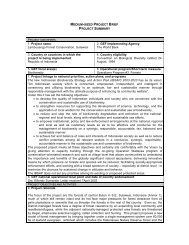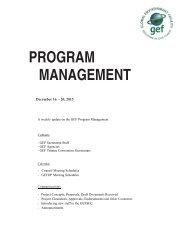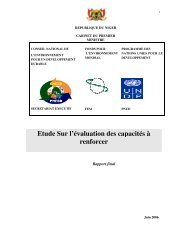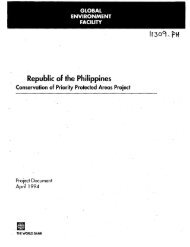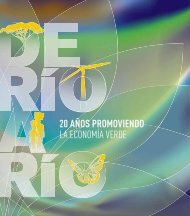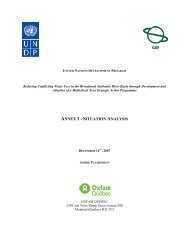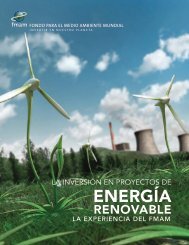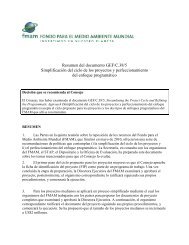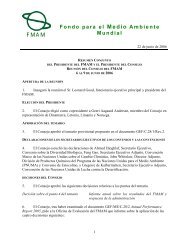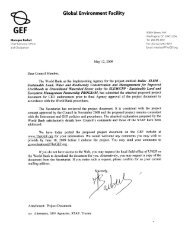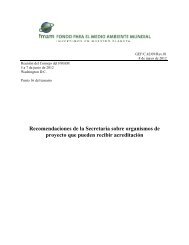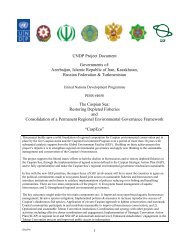- Page 2 and 3:
PART I: PROJECT INFORMATION GEFSEC
- Page 4 and 5:
3. Strengthening of income generati
- Page 6 and 7:
E. CONSULTANTS WORKING FOR TECHNICA
- Page 8 and 9:
management effectiveness within nat
- Page 10 and 11:
een identified among plants, amphib
- Page 12 and 13:
trails, 103Km), only two PAs have a
- Page 14 and 15:
array of natural, historical and cu
- Page 16 and 17:
payments for environmental services
- Page 18 and 19:
the International Park “La Amista
- Page 20 and 21:
egulatory framework for mainstreami
- Page 22 and 23:
of coastal and marine resources. Th
- Page 24 and 25:
F. DISCUSS THE VALUE-ADDED OF GEF I
- Page 26 and 27:
5. In summary, the incremental reas
- Page 28 and 29:
c. Creating the conditions for up-s
- Page 30 and 31:
PART IV: EXPLAIN THE ALIGNMENT OF P
- Page 32 and 33:
ANNEX A: PROJECT RESULTS FRAMEWORK
- Page 34 and 35:
Matrix of Indicators Component 1 Ba
- Page 36 and 37:
Component 2 Base Year 1 Year 2 Year
- Page 38 and 39:
Component 3 Base Year 1 Year 2 Year
- Page 40 and 41:
Component 3 Base Year 1 Year 2 Year
- Page 42 and 43:
February 23, 2009 Please ensure coo
- Page 44 and 45:
Title of the Position $/ Estimat We
- Page 46 and 47:
Title of the Position $/ Estimat We
- Page 48 and 49:
Title of the Position $/ Estimat We
- Page 50 and 51:
Diagnostic of existing ecotourism s
- Page 52 and 53:
ANNEX E: Ecotourism resources and p
- Page 54 and 55:
Name of Protected Area Resources wi
- Page 56 and 57:
Name of Protected Area PN Chagres -
- Page 58 and 59:
ANNEX F: SINAP AND PRIORITY PROTECT
- Page 60 and 61:
-iii- CONTENT PROJECT SUMMARY .....
- Page 62 and 63:
-v- PROJECT SUMMARY PANAMA ABREVIAT
- Page 64 and 65:
A. Background - 2 - I. DESCRIPTION
- Page 66 and 67:
- 4 - hectare in SINAP is about hal
- Page 68 and 69:
- 6 - infrastructure, technology an
- Page 70 and 71:
- 8 - carrying capacity 6 , flow ma
- Page 72 and 73:
- 10 - # of PA with linked biologic
- Page 74 and 75:
C. Fiduciary Risk - 12 - 2.7 Based
- Page 76 and 77:
2. Coordination - 14 - 3.3 A Steeri
- Page 78 and 79:
GEF-4 Tracking Tool for Biodiversit
- Page 80 and 81:
GEF-4 Tracking Tool for Biodiversit
- Page 82 and 83:
3 GEF-4 Tracking Tool for Biodivers
- Page 84 and 85:
Coiba National Park No 256,195 ha a
- Page 86 and 87:
GEF-4 Tracking Tool for Biodiversit
- Page 88 and 89:
Annual budget (US$) - excluding sta
- Page 90 and 91:
Protected Areas Threats: Data Sheet
- Page 92 and 93:
GEF-4 Tracking Tool for Biodiversit
- Page 94 and 95:
GEF-4 Tracking Tool for Biodiversit
- Page 96 and 97:
GEF-4 Tracking Tool for Biodiversit
- Page 98 and 99:
GEF-4 Tracking Tool for Biodiversit
- Page 100 and 101:
GEF-4 Tracking Tool for Biodiversit
- Page 102 and 103:
GEF-4 Tracking Tool for Biodiversit
- Page 104 and 105:
GEF-4 Tracking Tool for Biodiversit
- Page 106 and 107:
GEF-4 Tracking Tool for Biodiversit
- Page 108 and 109:
GEF-4 Tracking Tool for Biodiversit
- Page 110 and 111:
GEF-4 Tracking Tool for Biodiversit
- Page 112 and 113:
3 GEF-4 Tracking Tool for Biodivers
- Page 114 and 115:
Coiba National Park No 256,195 ha a
- Page 116 and 117:
GEF-4 Tracking Tool for Biodiversit
- Page 118 and 119:
. Management Objective 1 GEF-4 Trac
- Page 120 and 121:
GEF-4 Tracking Tool for Biodiversit
- Page 122 and 123:
GEF-4 Tracking Tool for Biodiversit
- Page 124 and 125:
GEF-4 Tracking Tool for Biodiversit
- Page 126 and 127:
GEF-4 Tracking Tool for Biodiversit
- Page 128 and 129:
GEF-4 Tracking Tool for Biodiversit
- Page 130 and 131:
GEF-4 Tracking Tool for Biodiversit
- Page 132 and 133:
GEF-4 Tracking Tool for Biodiversit
- Page 134 and 135:
Strategic Programs for GEF-4 under
- Page 136 and 137:
GEF-4 Tracking Tool for Biodiversit
- Page 138 and 139:
La Amistad International Park Altos
- Page 140 and 141:
Soberania National Park Baru Volcan
- Page 142 and 143:
GEF-4 Tracking Tool for Biodiversit
- Page 144 and 145:
GEF-4 Tracking Tool for Biodiversit
- Page 146 and 147:
GEF-4 Tracking Tool for Biodiversit
- Page 148 and 149:
GEF-4 Tracking Tool for Biodiversit
- Page 150 and 151:
GEF-4 Tracking Tool for Biodiversit
- Page 152 and 153:
GEF-4 Tracking Tool for Biodiversit
- Page 154 and 155:
GEF-4 Tracking Tool for Biodiversit
- Page 156 and 157:
GEF-4 Tracking Tool for Biodiversit
- Page 158 and 159:
GEF-4 Tracking Tool for Biodiversit
- Page 160 and 161:
GEF-4 Tracking Tool for Biodiversit
- Page 162 and 163:
GEF-4 Tracking Tool for Biodiversit
- Page 164 and 165:
GEF-4 Tracking Tool for Biodiversit
- Page 166 and 167:
3 GEF-4 Tracking Tool for Biodivers
- Page 168 and 169:
Coiba National Park No 256,195 ha a
- Page 170 and 171:
GEF-4 Tracking Tool for Biodiversit
- Page 172 and 173:
GEF-4 Tracking Tool for Biodiversit
- Page 174 and 175:
GEF-4 Tracking Tool for Biodiversit
- Page 176 and 177:
GEF-4 Tracking Tool for Biodiversit
- Page 178 and 179:
GEF-4 Tracking Tool for Biodiversit
- Page 180 and 181:
GEF-4 Tracking Tool for Biodiversit
- Page 182 and 183:
GEF-4 Tracking Tool for Biodiversit
- Page 184 and 185:
GEF-4 Tracking Tool for Biodiversit
- Page 186 and 187:
GEF-4 Tracking Tool for Biodiversit
- Page 188 and 189:
GEF-4 Tracking Tool for Biodiversit
- Page 190 and 191:
GEF-4 Tracking Tool for Biodiversit
- Page 192 and 193:
3 GEF-4 Tracking Tool for Biodivers
- Page 194 and 195:
Coiba National Park No 256,195 ha a
- Page 196 and 197:
GEF-4 Tracking Tool for Biodiversit
- Page 198 and 199:
Including: (tick boxes) GEF-4 Track
- Page 200 and 201:
GEF-4 Tracking Tool for Biodiversit
- Page 202 and 203:
GEF-4 Tracking Tool for Biodiversit
- Page 204 and 205:
GEF-4 Tracking Tool for Biodiversit
- Page 206 and 207:
GEF-4 Tracking Tool for Biodiversit
- Page 208 and 209:
GEF-4 Tracking Tool for Biodiversit
- Page 210 and 211:
GEF-4 Tracking Tool for Biodiversit
- Page 212 and 213:
GEF-4 Tracking Tool for Biodiversit
- Page 214 and 215:
GEF-4 Tracking Tool for Biodiversit
- Page 216 and 217:
GEF-4 Tracking Tool for Biodiversit
- Page 218 and 219:
3 GEF-4 Tracking Tool for Biodivers
- Page 220 and 221:
Coiba National Park No 256,195 ha a
- Page 222 and 223:
GEF-4 Tracking Tool for Biodiversit
- Page 224 and 225:
What are the main values for which
- Page 226 and 227:
GEF-4 Tracking Tool for Biodiversit
- Page 228 and 229:
GEF-4 Tracking Tool for Biodiversit
- Page 230 and 231:
GEF-4 Tracking Tool for Biodiversit
- Page 232 and 233:
GEF-4 Tracking Tool for Biodiversit
- Page 234 and 235:
GEF-4 Tracking Tool for Biodiversit
- Page 236 and 237:
GEF-4 Tracking Tool for Biodiversit
- Page 238 and 239:
GEF-4 Tracking Tool for Biodiversit
- Page 240 and 241:
GEF-4 Tracking Tool for Biodiversit
- Page 242 and 243:
GEF-4 Tracking Tool for Biodiversit
- Page 244 and 245:
GEF-4 Tracking Tool for Biodiversit
- Page 246 and 247:
Strategic Programs for GEF-4 under
- Page 248 and 249:
GEF-4 Tracking Tool for Biodiversit
- Page 250 and 251:
La Amistad International Park Altos
- Page 252 and 253:
Soberania National Park Baru Volcan
- Page 254 and 255:
GEF-4 Tracking Tool for Biodiversit
- Page 256 and 257:
GEF-4 Tracking Tool for Biodiversit
- Page 258 and 259:
GEF-4 Tracking Tool for Biodiversit
- Page 260 and 261:
GEF-4 Tracking Tool for Biodiversit
- Page 262 and 263:
GEF-4 Tracking Tool for Biodiversit
- Page 264 and 265:
GEF-4 Tracking Tool for Biodiversit
- Page 266 and 267:
GEF-4 Tracking Tool for Biodiversit
- Page 268 and 269:
GEF-4 Tracking Tool for Biodiversit
- Page 270 and 271: GEF-4 Tracking Tool for Biodiversit
- Page 272 and 273: GEF-4 Tracking Tool for Biodiversit
- Page 274 and 275: GEF-4 Tracking Tool for Biodiversit
- Page 276 and 277: GEF-4 Tracking Tool for Biodiversit
- Page 278 and 279: 3 GEF-4 Tracking Tool for Biodivers
- Page 280 and 281: Coiba National Park No 256,195 ha a
- Page 282 and 283: GEF-4 Tracking Tool for Biodiversit
- Page 284 and 285: GEF-4 Tracking Tool for Biodiversit
- Page 286 and 287: GEF-4 Tracking Tool for Biodiversit
- Page 288 and 289: GEF-4 Tracking Tool for Biodiversit
- Page 290 and 291: GEF-4 Tracking Tool for Biodiversit
- Page 292 and 293: GEF-4 Tracking Tool for Biodiversit
- Page 294 and 295: GEF-4 Tracking Tool for Biodiversit
- Page 296 and 297: GEF-4 Tracking Tool for Biodiversit
- Page 298 and 299: GEF-4 Tracking Tool for Biodiversit
- Page 300 and 301: GEF-4 Tracking Tool for Biodiversit
- Page 302 and 303: GEF-4 Tracking Tool for Biodiversit
- Page 304 and 305: GEF-4 Tracking Tool for Biodiversit
- Page 306 and 307: GEF-4 Tracking Tool for Biodiversit
- Page 308 and 309: GEF-4 Tracking Tool for Biodiversit
- Page 310 and 311: 3 GEF-4 Tracking Tool for Biodivers
- Page 312 and 313: Coiba National Park No 256,195 ha a
- Page 314 and 315: GEF-4 Tracking Tool for Biodiversit
- Page 316 and 317: GEF-4 Tracking Tool for Biodiversit
- Page 318 and 319: GEF-4 Tracking Tool for Biodiversit
- Page 322 and 323: GEF-4 Tracking Tool for Biodiversit
- Page 324 and 325: GEF-4 Tracking Tool for Biodiversit
- Page 326 and 327: GEF-4 Tracking Tool for Biodiversit
- Page 328 and 329: GEF-4 Tracking Tool for Biodiversit
- Page 330 and 331: GEF-4 Tracking Tool for Biodiversit
- Page 332 and 333: GEF-4 Tracking Tool for Biodiversit
- Page 334 and 335: GEF-4 Tracking Tool for Biodiversit
- Page 336 and 337: GEF-4 Tracking Tool for Biodiversit
- Page 338 and 339: 2 registered: number of individuals
- Page 340 and 341: 4 project year, which will summariz
- Page 342 and 343: 6 1.18 The Project may be asked to
- Page 344: 8 Independent Mid-Term Evaluation I



